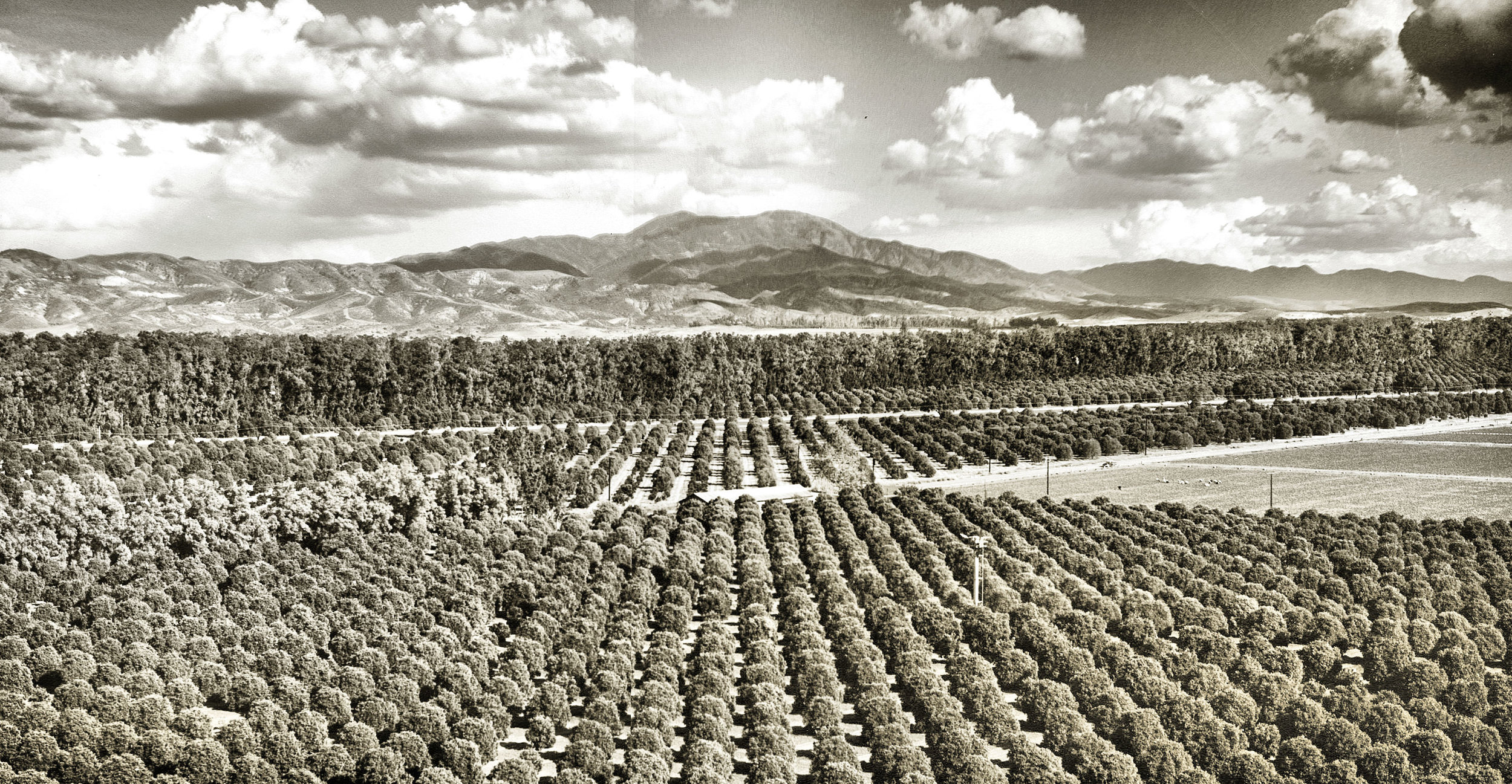Looking across the orange groves of the Irvine Ranch towards Old Saddleback, circa 1956 (courtesy the Orange Public Library and History Center).
A (Very) Brief History of Orange County
Indians lived here for centuries before the first Spanish explorers entered what is now Orange County in 1769. Within a few years, the missions San Gabriel (1771) and San Juan Capistrano (1776) laid claim to much of the area. A few grazing concessions were given to retired soldiers before the end of Spanish rule in 1821, but it was not until the Mexican government secularized the missions in the 1830s that the Rancho Era truly began. By the start of the Mexican War in 1846, nearly all of Orange County except the mountain regions had been granted to the rancheros.
These great cattle ranches were the backbone of the local economy until the drought of 1863-64. The only communities worthy of the name were at San Juan Capistrano and Old Santa Ana (Olive). Then in 1857, a group of Germans immigrants living in San Francisco joined together in a cooperative venture to found an agricultural colony they named Anaheim.
Two events in 1868 opened up much of the Santa Ana Valley to settlers. South and east of the Santa Ana River, the old Rancho Santiago de Santa Ana – long the stronghold of the Yorba and Peralta families – was broken up and divided among scores of heirs and owners. While on the other side of the river, debt forced Abel Stearns to place his extensive landholdings into the hands of a trust. The Los Angeles & San Bernardino Land Company began offering thousands of acres of the Stearns Ranchos for sale. New towns sprang up almost immediately on both sides of the river – Santa Ana, Tustin, Orange, Westminster, Garden Grove – and settlers spread out across the land.
The Southern Pacific railroad arrived in the mid-1870s, but it was not until the Santa Fe completed a direct transcontinental link into Southern California that the full impact of the railroads was felt. Competition between the two railroads helped to launch Southern California’s greatest real estate boom. During the frantic “Boom of the Eighties” (1886-88), scores of subdivisions were platted and more than a dozen new towns were laid out here. But the Boom collapsed as quickly as it had begun, and only Fullerton, Buena Park, and El Toro survived to become incorporated cities.
The Boom also led to the creation of Orange County in 1889. It had been almost two decades since the first proposal to split off the southern end of Los Angeles County had been sent to Sacramento. The flush years of the Boom and the rise in population gave the Santa Ana Valley the financial and political clout it needed to finally form its own county.
As Orange County moved into the 20th century, transportation continued to play a key role in our development. Between 1905 and 1910, the Pacific Electric Railway built three main lines into Orange County – one along the coast from Seal Beach to Balboa, a second across the center of the valley through Cypress and Garden Grove on its way to Santa Ana, and a third to serve the northern communities of La Habra, Brea, and Yorba Linda. The PE’s “big red cars” brought a surge of new townsites and subdivisions along the tracks.
Beginning around 1910, the automobile also started to have an impact. As good roads were built through the county, development followed. By the mid-1920s the bigger cities – Santa Ana, Anaheim, Fullerton, Huntington Beach – were surrounded by smaller tracts and townsites out on the highways.
Railroads, red cars, roads, and eventually freeways; wherever they led, development always followed.
The county’s economy remained largely agricultural until the 1950s. Not just oranges, but lemons, apricots, walnuts, lima beans, celery, sugar beets, and avocados all thrived here. Other farmers grew wheat, barley, tomatoes, strawberries, or other row crops, kept dairy cattle, or raised chickens.
Oil also helped to fuel Orange County’s growth. From a small beginning in the 1880s along the northern edge of the county, the oil industry burst into prominence in 1919-20, when major strikes were made at Placentia and Huntington Beach. Soon hundreds of wells dotted the county, from the northern foothills right down to the water’s edge along the coast.
Yet by 1940, Orange County’s population was still only 130,000, while California was nearing seven million.
World War II would help change all that. Huge military installations were established throughout the county, and thousands of men and women passed through here on their way overseas. After the war, many returned to settle here. The post-war boom hit Orange County with a vengeance in the 1950s, and communities such as Garden Grove and Buena Park grew at a dizzying rate. By 1963, Orange County’s population had topped one million.
But to the south, things went along pretty much as they always had. Most of the southern third of the county was held by a few large ranch owners – the Irvines, O’Neills, Moultons and others. Cattle ranching and farming were still king in the South County as late as 1960. But as imported water became available, and the Santa Ana Freeway pushed south towards San Diego, the big ranches were developed as master-planned communities, and the South County began to shine.
Today, high tech, light industry, and the service sector have replaced agriculture as the basis of the local economy. Our population has grown increasingly diverse, as immigrants from across the world have settled here. With a population over three million, much of Orange County has been built up, but many new tracts and new developments are yet to come.
